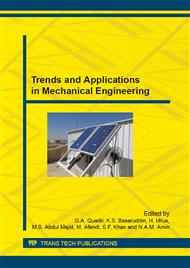[1]
Yi-Ming Jen, Yung-Chuan Chiou, Chen-Li Yu, Fracture mechanics study on the intermetallic compound cracks for the solder joints of electronic packages, Eng. Failure Analysis 18 (2011) 797–810.
DOI: 10.1016/j.engfailanal.2010.12.026
Google Scholar
[2]
Yanhong Tian, Chunjin Hang, Chunqing Wang, Shihua Yang, Pengrong Lin, Effects of bump size on deformation and fracture behavior of Sn3. 0Ag0. 5Cu/Cu solder joints during shear testing, Materials Science and Engineering A 529 (2011) 468– 478.
DOI: 10.1016/j.msea.2011.09.063
Google Scholar
[3]
Emeka H. Amalu, Ndy N. Ekere, High temperature reliability of lead-free solder joints in a flip chip assembly, Journal of Materials Processing Technology 212 (2012) 471– 483.
DOI: 10.1016/j.jmatprotec.2011.10.011
Google Scholar
[4]
M.O. Alam, H. Lu, Chris Bailey, Y.C. Chan, Fracture mechanics analysis of solder joint intermetallic compounds in shear test. Computational Materials Science 45 (2009) 576–583.
DOI: 10.1016/j.commatsci.2008.12.001
Google Scholar
[5]
Siva P.V. Nadimpalli, Jan K. Spelt, Effect of geometry on the fracture behavior of lead-free solder joints, Engineering Fracture Mechanics 78 (2011) 1169–1181.
DOI: 10.1016/j.engfracmech.2011.01.026
Google Scholar
[6]
Yao Yao, Leon M. Keer, Morris E. Fine, Modeling the failure of intermetallic/solder interfaces, Intermetallics 18 (2010) 1603-1611.
DOI: 10.1016/j.intermet.2010.04.016
Google Scholar
[7]
Xu Chen a, Y.C. Lin, Xingsheng Liu, 1, Guo-Quan Lu, Fracture mechanics analysis of the effect of substrateflexibility on solder joint reliability, Engineering Fracture Mechanics 72 (2005) 2628–2646.
DOI: 10.1016/j.engfracmech.2005.02.008
Google Scholar
[8]
De-Shin Liu, Chia-Yuan Kuo, ∗, Chang-Lin Hsu, Geng-Shin Shen, Yu-Ren Chen, Kuo-Cheng Lo, Failure mode analysis of lead-free solder joints under high speed impact testing, Materials Science and Engineering A 494 (2008) 196–202.
DOI: 10.1016/j.msea.2008.04.015
Google Scholar
[9]
Y. -L. Shen , K. Aluru, Numerical study of ductile failure morphology in solder joints under fast loading conditions, Microelectronics Reliability 50 (2010) 2059–(2070).
DOI: 10.1016/j.microrel.2010.06.001
Google Scholar
[10]
K. Aluru, F. -L. Wen, Y. -L. Shen, Direct simulation of fatigue failure in solder joints during cyclic shear, Materials and Design 32 (2011) 1940–(1947).
DOI: 10.1016/j.matdes.2010.11.072
Google Scholar
[11]
J.H. Lee, H. -Y. Jeong, Fatigue life prediction of solder joints with consideration of frequency, temperature and cracking energy density, International Journal of Fatigue, v61 (2014): 264-270.
DOI: 10.1016/j.ijfatigue.2013.10.021
Google Scholar
[12]
Siva P.V. Nadimpalli, Jan K. Spelt, Mixed-mode fracture load prediction in lead-free solder joints, Engineering Fracture Mechanics 78 (2011) 317–333.
DOI: 10.1016/j.engfracmech.2010.09.011
Google Scholar
[13]
Siva P.V. Nadimpalli, Jan K. Spelt, Fracture load prediction of lead-free solder joints, Engineering Fracture Mechanics 77 (2010) 3446–3461.
DOI: 10.1016/j.engfracmech.2010.09.012
Google Scholar
[14]
Q.K. Zhang, Z.F. Zhang, Thermal fatigue behaviors of Sn–4Ag/Cu solder joints at low strain amplitude, Materials Science&EngineeringA580(2013) 374–384.
DOI: 10.1016/j.msea.2013.05.061
Google Scholar
[15]
K.S. Siow, M. Manoharan, Mixed mode fracture toughness of lead–tin and tin–silver solder joints with nickel-plated substrate, Materials Science and Engineering A 404 (2005) 244–250.
DOI: 10.1016/j.msea.2005.05.086
Google Scholar


